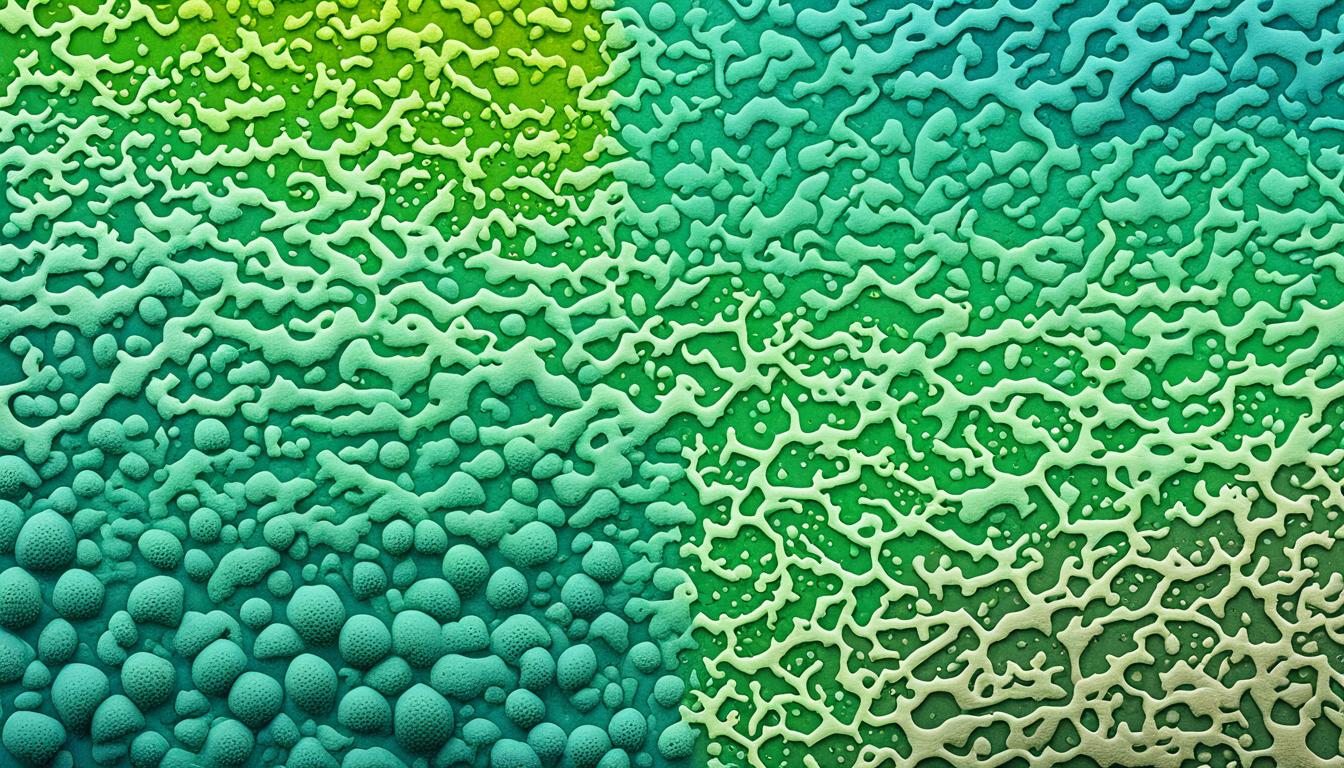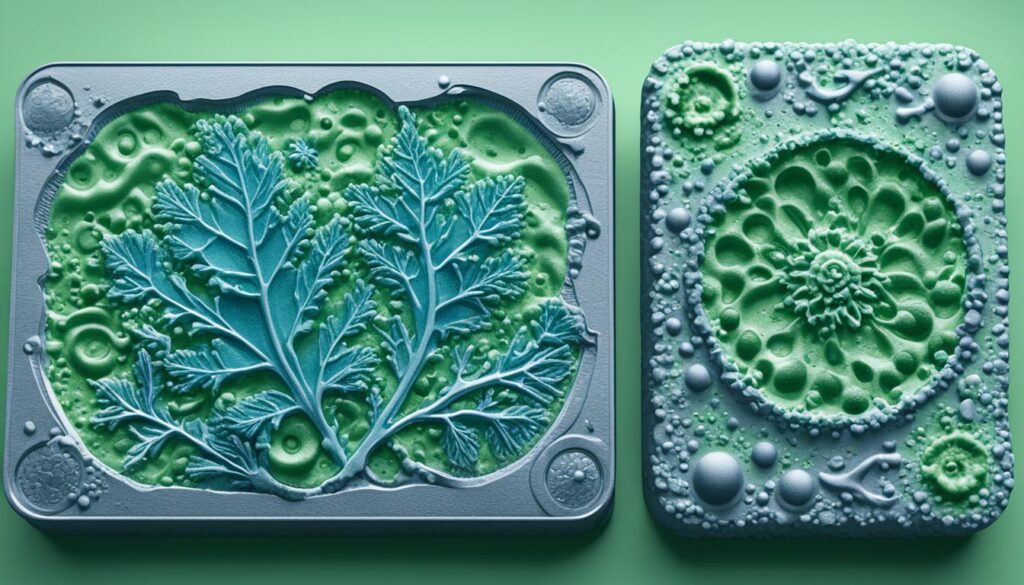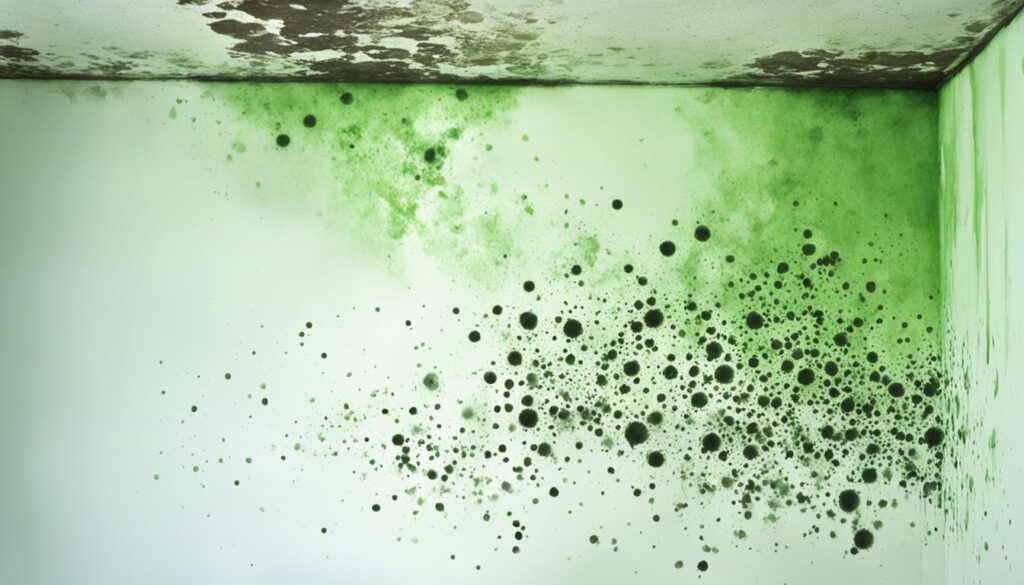
Identifying Mold: Types and Safety Hazards Explained
In this section, we will delve into the crucial topic of identifying mold and understanding the different types of mold that can pose safety hazards. Mold is a common issue that can affect homes, buildings, and even our health. By gaining knowledge about mold identification, we can take necessary precautions to protect ourselves and our environment.
Mold is a type of fungus that thrives in damp and humid conditions. It can grow on various surfaces, including walls, floors, and even household items. Mold spores are microscopic and can easily become airborne, making them easy to inhale and causing potential health risks.
To ensure your safety, it’s essential to be aware of the different types of mold that may be present in your surroundings. Some molds are harmless, while others can be hazardous to our health, especially for individuals with respiratory conditions or weakened immune systems.
By understanding the risks associated with different types of mold, you can implement effective mold detection, inspection, and prevention strategies. This knowledge will empower you to create a safe and healthy living or working environment for yourself and those around you.
Key Takeaways:
- Identifying mold and understanding its types is crucial for maintaining a safe environment.
- Mold is a fungus that grows in damp and humid conditions.
- Mold spores are microscopic and can become airborne, leading to potential health risks.
- Some molds can be hazardous, especially for individuals with respiratory conditions or weakened immune systems.
- Knowing the risks associated with different mold types helps in implementing effective detection, inspection, and prevention strategies.
Understanding Mold: What is it and How Does it Form?
Before delving into the different types of mold and the safety hazards they present, it is important to have a clear understanding of what exactly mold is and how it forms. Mold is a type of fungus that thrives in damp, dark, and humid environments. It reproduces by releasing spores into the air, which can then settle and grow on various surfaces.
Mold can form and proliferate in both indoor and outdoor settings, but it becomes a concern when it starts growing indoors, posing potential health risks and structural damage. It is crucial to be aware of the common factors that contribute to mold growth in order to effectively prevent and address mold issues in your environment.
Growth Factors:
- Moisture: Mold requires moisture to grow, so areas with water leaks, high humidity levels, or inadequate ventilation are prime breeding grounds for mold.
- Organic Materials: Mold feeds on organic materials such as wood, paper, fabric, and drywall. These materials provide nutrients that support mold growth when combined with the right conditions.
- Warmth: Mold thrives in warm temperatures, typically between 77°F and 86°F (25°C and 30°C). Warmer environments create an ideal habitat for mold to flourish.
- Darkness: Mold prefers dark areas where it can thrive undisturbed. This is why mold is often found in hidden spaces like basements, crawl spaces, and behind walls.
Common Indoor Environments for Mold Growth:
- Basements and crawl spaces
- Bathrooms and kitchens
- Attics and roof spaces
- Leaking pipes or plumbing fixtures
- Flooded or water-damaged areas
Signs of Mold Presence:
The presence of mold can be indicated by various signs. These signs may include:
- Visible mold growth on surfaces, such as walls, ceilings, or furniture
- A musty or earthy odor in certain areas
- Water stains or discoloration on walls or ceilings
- Peeling or bubbling paint or wallpaper
- Allergic reactions, such as sneezing, coughing, or nasal congestion, when spending time in a specific area
Common Types of Mold: Identifying the Culprits
Mold is a common issue in many homes and buildings, and it can appear in various forms and colors. Each type of mold has its own unique characteristics and poses different risks to human health. By being able to identify the different types of mold, you can take appropriate measures to ensure a safe and healthy environment.
Here are the most common types of mold found in homes and buildings:
| Mold Type | Appearance | Health Hazards |
|---|---|---|
| 1. Stachybotrys Chartarum (Black Mold) | Black or dark green, slimy texture | Respiratory issues, skin irritation, allergic reactions |
| 2. Aspergillus | Varies in color, powdery texture | Allergic reactions, asthma attacks, lung infections |
| 3. Penicillium | Blue or green, fuzzy texture | Allergic reactions, respiratory problems, sinus infections |
| 4. Cladosporium | Olive-green or brown, suede-like texture | Allergic reactions, asthma attacks, skin infections |
| 5. Alternaria | Darker green or brown, velvety texture | Allergic reactions, asthma attacks, respiratory infections |
It is important to note that these are just a few examples of the many types of mold that can be found. Each type requires specific remediation methods and precautions to protect your health.
Proactively identifying the culprits of mold in your environment is essential for taking appropriate action. If you suspect mold growth in your home or building, consider consulting a professional mold remediation service for accurate mold identification and effective removal.
Being knowledgeable about the types of mold and their potential health hazards empowers you to create a healthier living or working environment for yourself and those around you.

Health Risks of Mold Exposure: What You Need to Know
Exposure to mold can pose significant health risks, particularly for individuals with respiratory conditions, allergies, or weakened immune systems. In this section, we will delve into the potential adverse effects of mold exposure and the long-term implications it can have on individuals.
Mold exposure can lead to a wide range of health issues, including:
- Respiratory problems: Inhaling mold spores can trigger or worsen respiratory conditions such as asthma, allergies, and chronic obstructive pulmonary disease (COPD). The inhalation of mold can irritate the airways and cause symptoms like coughing, wheezing, shortness of breath, and chest tightness.
- Allergic reactions: Mold spores are known allergens and can provoke allergic reactions in susceptible individuals. Common symptoms of mold allergies include sneezing, runny or stuffy nose, itchy and watery eyes, and skin rashes.
- Exacerbation of existing conditions: Individuals with compromised immune systems or pre-existing respiratory conditions may experience more severe symptoms when exposed to mold.
- Infections: Certain types of mold, such as Aspergillus and Stachybotrys chartarum, also known as “black mold,” can produce mycotoxins that have the potential to cause infections in the respiratory system, skin, or even the internal organs.
“The hazards of mold exposure should not be underestimated. It is essential to address mold problems promptly and take necessary precautions to protect your health and well-being.” – Dr. Sarah Roberts, Environmental Health Expert
To better understand the health risks associated with mold exposure, it is crucial to be aware of the hazardous mold types that commonly occur in indoor environments. Let’s take a closer look at some of the most notorious mold species:
| Mold Type | Description | Health Hazards |
|---|---|---|
| Stachybotrys chartarum (Black Mold) | A greenish-black mold that thrives in damp areas with high cellulose content, such as drywall and wood. It releases mycotoxins that can cause severe respiratory problems, skin irritation, and even neurological issues. | – Respiratory problems – Allergic reactions – Neurological symptoms – Skin and eye irritation |
| Aspergillus | A green, gray, or brown mold commonly found in warm and humid environments. It can produce mycotoxins that can cause allergic reactions, respiratory infections, and long-term lung damage. | – Allergic reactions – Respiratory infections – Lung damage – Weakened immune response |
| Penicillium | A blue or green mold commonly found in water-damaged areas. It can produce mycotoxins that can cause allergic reactions, respiratory symptoms, and chronic sinusitis. | – Allergic reactions – Respiratory symptoms – Chronic sinusitis – Eye and skin irritation |
It is vital to prioritize mold safety and take appropriate measures to minimize the risks of exposure. This includes regular inspections, prompt remediation, and maintaining proper indoor ventilation and moisture control.
Detecting Mold: Signs and Symptoms
Mold can be present in your environment without you even realizing it. Detecting mold early is essential for taking appropriate actions to prevent its spread and protect your health. In this section, we will explore the common signs and symptoms of mold presence, both visible and hidden. We will also emphasize the importance of professional mold inspections in identifying and addressing mold issues effectively.
Visible Signs of Mold
Mold growth can often be seen with the naked eye. Look out for the following visible signs:
- Discoloration: Dark, green, black, or white patches on walls, ceilings, or other surfaces may indicate mold growth.
- Texture Changes: Mold-infested areas may appear fuzzy, slimy, or have a powdery texture.
- Musty Odor: A strong, earthy smell may indicate the presence of mold, even if it’s not immediately visible.
Hidden Signs of Mold
Mold can also thrive in hidden areas where it’s not easily visible. Pay attention to the following hidden signs:
- Water Intrusion: Any history of water leaks, floods, or moisture buildup increases the likelihood of hidden mold growth.
- Unexplained Health Symptoms: If you or your family members experience persistent coughing, sneezing, congestion, or other respiratory issues, it could be due to mold exposure.
“Mold is like an iceberg – it’s only the tip that we see. The majority of mold growth happens behind walls, under carpets, or in damp basements. Professional mold inspections are crucial to detect hidden mold and ensure a thorough assessment of your indoor environment.”
The Importance of Professional Mold Inspections
While visible mold may be an obvious indication of a problem, detecting hidden mold requires the expertise of professionals. Certified mold inspectors have the knowledge and tools to identify mold growth in inaccessible areas. They conduct thorough inspections, including air quality tests, moisture measurements, and visual examinations. Professional mold inspections provide you with a comprehensive understanding of mold presence and the necessary steps to take for its remediation and prevention.

| Visible Signs | Hidden Signs |
|---|---|
| Discoloration | Water Intrusion |
| Texture Changes | Unexplained Health Symptoms |
| Musty Odor |
Mold Inspection and Prevention: Protecting Your Indoor Environment
Regular mold inspections and implementing preventative measures are essential for maintaining a safe and healthy indoor environment. Mold can thrive in damp and poorly ventilated areas, posing health risks to inhabitants and causing damage to the structure of your home or building. In this section, we will explore the importance of mold inspections, the process involved, and effective strategies for preventing mold growth.
Mold Inspection: Ensuring Your Home is Mold-Free
When it comes to mold, prevention is always better than remediation. Regular mold inspections can help detect and address mold issues before they become significant problems. Mold inspections involve thorough assessments of your property to identify visible mold growth, as well as potential moisture sources that can contribute to mold development. Professional mold inspectors are trained to identify mold species, assess the extent of the damage, and provide recommendations for remediation.
Mold inspections can benefit homeowners, tenants, real estate agents, and property managers alike. Whether you suspect mold growth, planning to purchase a property, or want to ensure the safety of your current residence, scheduling a mold inspection can provide peace of mind and save you from potential health hazards and costly repairs in the long run.
Preventing Mold Growth: Effective Strategies
While mold inspections are crucial, preventing mold growth is equally important. Implementing mold prevention strategies can help create an environment that is inhospitable to mold and reduce the risk of its formation. Here are some effective strategies to prevent mold:
- Control Moisture Levels: Keep indoor humidity levels below 50% to minimize mold growth. Use dehumidifiers in damp areas such as basements, and fix leaks or water intrusions promptly.
- Proper Ventilation: Ensure proper ventilation in bathrooms, kitchens, and other areas prone to moisture buildup. Proper airflow can help prevent condensation and reduce the likelihood of mold growth.
- Regular Cleaning: Regularly clean and dry areas susceptible to mold, such as bathrooms, kitchens, and basements. Pay special attention to areas where moisture accumulates, such as shower curtains, sinks, and windowsills.
- Use Mold-Resistant Materials: When renovating or building, consider using mold-resistant materials such as mold-resistant drywall, paints, and caulking.
By implementing these preventative measures, you can significantly reduce the risk of mold growth in your home or building, ensuring the health and safety of everyone inside.
“Prevention is the key to maintaining a mold-free environment. Regular inspections and adopting preventative measures can greatly minimize the risk of mold and its potential hazards.”
Remember, mold prevention is an ongoing process. Regular inspections, proper maintenance, and prompt action in addressing moisture-related issues are essential for long-term mold prevention and a healthy indoor environment.
| Prevention Strategy | Advantages | Disadvantages |
|---|---|---|
| Controlling Moisture Levels | Reduces the favorable conditions for mold growth | May require regular monitoring and the use of dehumidifiers |
| Proper Ventilation | Improves air circulation and reduces condensation | May require installation or modification of existing ventilation systems |
| Regular Cleaning | Prevents the buildup of mold-friendly environments | Requires consistent cleaning efforts |
| Use of Mold-Resistant Materials | Provides an additional barrier against mold growth | May involve higher upfront costs for specialized materials |
By combining these strategies and staying vigilant, you can effectively protect your indoor environment from mold and create a healthier living or working space.
Remediation Techniques: Effective Ways to Remove Mold
If mold is detected in your environment, it is crucial to take immediate action to remove it safely and effectively. Mold can pose serious health risks and compromise the integrity of your property. In this section, we will discuss different remediation techniques that can help eliminate mold and prevent its recurrence. Whether you opt for DIY approaches or professional mold remediation services, it is important to prioritize mold safety and apply the right strategies for your specific situation.
Before attempting mold removal, it’s essential to follow proper safety precautions to minimize health risks. This includes wearing protective clothing, gloves, goggles, and a respirator to avoid inhaling mold spores. Additionally, ensure adequate ventilation in the affected area by opening windows or using fans to direct airflow outdoors.
DIY Mold Removal Techniques:
- Dry brushing or scrubbing: For small surface areas affected by mold growth, you can use a stiff brush or sponge to physically remove the mold. Ensure the surface is completely dry before brushing to prevent mold spores from spreading.
- Vinegar: Vinegar is a natural, non-toxic cleaner that can effectively kill mold. Mix equal parts vinegar and water in a spray bottle and apply it to the moldy surface. Let it sit for several hours before scrubbing the area clean.
- Baking soda: Baking soda is another natural remedy for mold removal. Create a paste by mixing baking soda with water, apply it to the affected area, and scrub gently. Rinse with water and dry the surface thoroughly.
Professional Mold Remediation Services:
If you’re dealing with a large mold infestation, extensive damage, or hazardous mold types such as Stachybotrys chartarum (black mold), it’s recommended to hire professional mold remediation services. Certified mold removal experts have the necessary experience, equipment, and knowledge to safely contain, remove, and properly dispose of mold without causing further contamination.
The process typically involves:
- Evaluating the extent of mold growth and identifying the source of moisture that caused it.
- Containing the affected area to prevent mold spores from spreading to other parts of the property.
- Using advanced equipment, such as air filtration devices and dehumidifiers, to remove excess moisture and improve air quality.
- Physically removing the mold using specialized cleaning agents and techniques.
- Ensuring thorough drying of the area to prevent future mold growth.
- Performing post-remediation inspections to verify the success of the removal process.
Hiring professionals for mold remediation not only ensures safe and effective removal but also provides peace of mind that the job is done correctly. It can help prevent future mold issues and protect the health and well-being of you and your loved ones.
Mold Remediation Guidelines
“The key to successful mold remediation lies in prompt action, proper safety measures, and choosing the most suitable approach based on the extent and severity of the mold infestation.”
Remember, mold prevention strategies such as moisture control, proper ventilation, and regular inspections are crucial to avoid mold growth and recurrence. If you suspect mold in your environment or need assistance with mold removal, consult a certified mold remediation professional for expert guidance and comprehensive solutions.
Conclusion
After understanding the various types of mold and the potential health hazards they pose, it is clear that identifying mold and taking appropriate measures is essential for maintaining a safe and healthy living or working environment. By implementing proper mold detection, inspection, and prevention strategies, you can safeguard yourself and others from the risks associated with mold exposure.
If you suspect the presence of mold in your surroundings, it is highly recommended to seek professional assistance for a thorough mold assessment and remediation. Fix Mold Miami is here to help. With their expertise in mold assessment and removal, you can ensure that your indoor space is mold-free and conducive for a healthy lifestyle. Contact Fix Mold Miami at 305-465-6653 to schedule a mold assessment appointment today.
Remember, early detection and proactive prevention are key in combating mold issues. Don’t wait until it becomes a major problem. Take action now to create a safe and mold-free environment for yourself, your family, or your co-workers. Protecting your health and well-being should always be a top priority.




